Anne Waldman feature:
Return to the Contents list
This piece is about 2,626 words
or 7 printed pages long
Eleni Sikelianos
The Lefevre-Sikelianos-Waldman Tree and the Imaginative Utopian Attempt
As ‘cultural incursionist’ I am a great-step-granddaughter of Anghelos and Eva Sikelianos, and the imaginative Utopian Attempt.
— Anne Waldman, “Sikelianos’s Delphic Idea: Site & Poetic Legacy,” Vow to Poetry
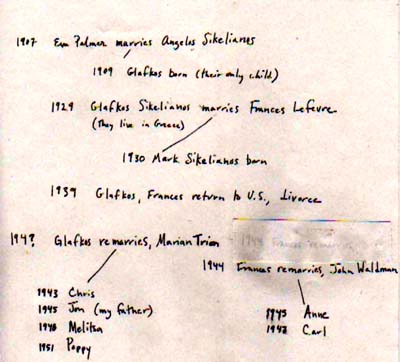
Family tree
Summer, 1965. Anne had just made the long drive across the country with her brother Carl and was on her way to the Berkeley Poetry Conference. There, she would hear Charles Olson read, meet Lewis Warsh, have her notions of becoming a poet reinforced; and beyond there, begin Angel Hair magazine, meet more poets, run the Poetry Project, co-found the Jack Kerouac School of Disembodied Poetics....
What stood out for me at Berkeley was the sense of community and the inter-connectedness of the chief “players.” There was a lot at stake, from some point of view, between Olson, Duncan, Ginsberg. Territory. It was all about macho turf — these guys in their sweet way were competitive for the leader-of-the-pack role. And real poetic issues were on the line: projective verse, composition by field, Whitmanic confessions and personalisms of all kinds. Who would last, who would have influence? ... Lenore Kandel was the only woman I remember presenting, and her poems were all paeans or enactments of female desire — more Dionysian than Apollonian. So the “figures” (already of lore & legend) were having conversations with each other whether they were speaking to each other or not. There was a thrilling undercurrent in events I attended — something about them both marking & making poetic history.
I had already been writing (since childhood really), but certainly these events and the meeting with Lewis Warsh & subsequent birth of Angel Hair Magazine reinforced the strong will and urge toward further activity & commitment. And the notion of writers in struggle — but together. I’ve described my response as a kind of “vow” [See Anne’s book of essays, Vow to Poetry, Coffee House Press, 2001]. I wanted to get closer to the energy, the interesting discussion, and the reasons why this was all so much more exciting and challenging than the going fare of straighter academic poetries....
I drove out to California with my brother Carl Waldman and a friend from Bennington. We stopped in Santa Barbara along the way.
— Anne Waldman, email to the author
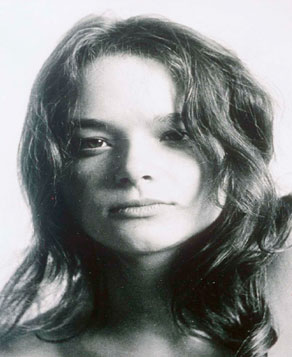
Anne, a few years after the Berkeley poetry conference.
She and Carl stopped in Santa Barbara to visit their mother’s first husband and his children from his second marriage; among these sort-of-siblings was my father. We all went out to hear the Scragg Family at the Bluebird café. Anne held me in her arms. I was six weeks old, and she was 20.
I remember visiting Glafkos in his retreat-like digs in the hills above town. The place was very spare; book on Tibetan Buddhism caught my eye.
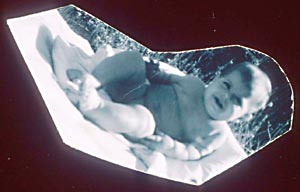
Me, five or six months after I first met Anne.
This was just as “the poetry net was widening, inviting” Anne to step in and start the long path from Silo (the literary magazine she was working on as an undergrad at Bennington) to today.
What we hadn’t known when Anne held me in her arms, or what we hadn’t yet formulated, is that there was a strange configuration already underway, about to arise and inscribe itself further. A branch of the arbor vitae that Anne envisioned in San Francisco that very summer: the roots and branches of her history as a poet, even prior to her own birth, and the continuation of that lineage as passed on to others.
A marriage between our families in the very early years, before Anne was born, would feed the roots of her poetic consciousness; and it would cross over again as my own early poetic gestures were nourished by Anne.
But let us leap back to 1929, the year a young woman named Frances LeFevre met a just-as-young half-Greek on his visit to America. Frances was 19 years old, and so was her beau, Glafkos Sikelianos. They seem to have fallen into each other’s arms, nearly immediately married, and just as immediately set sail for Greece. It would be some years (25, to be exact) before Frances would give birth to Anne, via her second husband, John Waldman.
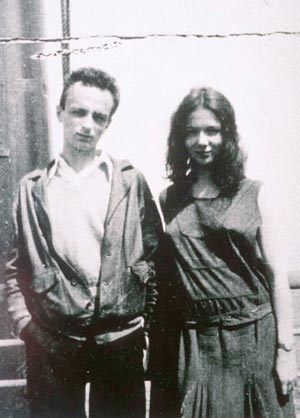
Glafkos and Frances. The back of the photograph reads:
“just married”
on the SS Belgian
July 1929
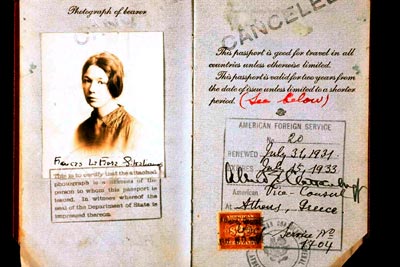
Passport
In the meantime, Frances had other adventures in front of her. She settled into a life between Athens, the small Corinthian gulf town of Sykia, and Delphi, each site close to her new parents-in-law. Eva Palmer Sikelianos and her husband Angelos were just then frantically preparing for the second Delphic Festival, to take place in 1930.
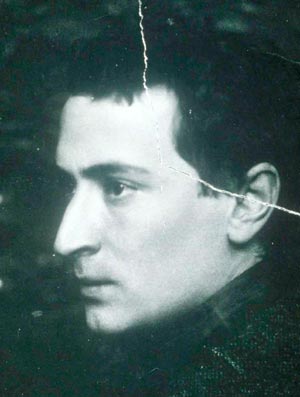
The poet Angelos Sikelianos (1884–1951), Frances’s new father-in-law; my great-grandfather.
Angelos Sikelianos, who would later be nominated for the Nobel prize, was already famous in Greece. The role of poet was one he feverishly embraced, taking it upon himself to recite his poems to trees. There are many stories of his exploits, but perhaps the most famous involves one of his best friends, Nikos Kazantzakis, while the two were on a pilgrimage to Mt. Athos. Legend has it that along the way a mailman (or, depending on who is telling the tale, an innkeeper, or an innkeeper’s wife; anyway, someone) died; Angelos was asked to, or he believed that he could, revive the dead body by lying atop it; he or someone in his company thought that his own heat and fervor might bring the corpse back to life. Apparently, he failed, and after a time descended from the upper rooms where the body lay. “Alas,” he said, “the Muse wasn’t with me today.”
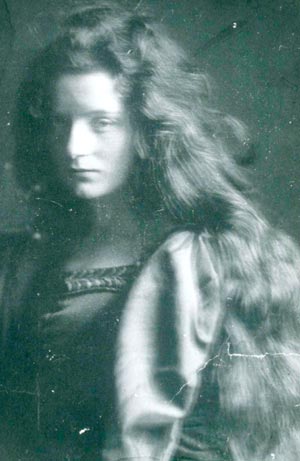
Eva Palmer Sikelianos (1875–1952), Frances’s mother-in-law; my great-grandmother.
Eva Palmer was a bisexual biscuit-fortune heiress who reportedly initiated Nathalie Barney, her lover of many years, into lesbian sex when they were teens. Eva and Angelos had been introduced by Angelos’s sister, Penelope, and her husband, Raymond Duncan (Isadora’s brother). The two soon hatched a plan to revive the ancient theatre, art and games festival at Delphi. Eva would supply the money, hard-work and know-how (the last of which she gathered along the way), and Angelos would provide the inspiration.
The husband and wife team wanted to establish a cultural center [and university] at Delphi that would unite people from all over the world. They believed that Delphi was still a world center with the power to inspire human perfection. The couple organized revivals of the Delphic Festivals in 1927 and 1930 that featured their own productions of Aeschylus’s plays [as well as Delphic games and an arts and crafts show]. Attracting an international audience of artists and intellectuals, they made Delphi a place of pilgrimage, as it had been in ancient times.
— Vassilis Lambropoulos, in an introduction to Anne, reading at the University of Michigan
From Anne’s “Sikelianos’s Delphic Idea: Site & Poetic Legacy”:
There’s a hilarious account Eva gives in her autobiography Upward Panic of casting her elegantly custom-tailored Parisian clothes out the window of a train as she traveled to join her soulmate Anghelos[1]:
On leaving Aix, I got into my railway compartment and undressed as quickly as I could. I slipped on one of my straight dresses and my sandals, and then started feverishly making a bundle. Everything I had bought in Paris — dresses, shoes, coat, hats, stockings, slippers, gloves — everything was piled into a railroad sheet, which afterward I paid for. Then up went the window and out went the bundle as the train thundered through the night. My relief was intense. That sort of thing was definitely over for me. I would never again wear clothes cut and sewed in silly shapes, and I would never again be touched by stuffs turned out by machines....

Eva and Glaukos, c. 1912.
Left: Photo of a photo (taken through glass) from the present-day Sikelianos museum. You can see that they’re wearing home-woven togas, which Eva continued to wear (even when she returned, years later, to New York City[2]) until her death.
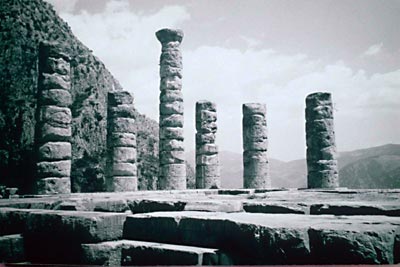
Delphi (Δελφοι, “wombs”): the temple of Apollo, as it stands today, where the Pythian priestess inhaled fumes and spoke the garbled will of the oracle, which was then translated into poetry.
Delphi... is the chosen center where a new Temple must be built; not one of marble columns, but a temple whose pediment shall be Education, Economy, and Justice for the whole earth.
— Upward Panic, Eva’s autobiography
“The Sikelianos utopia,” writes Anne, “was perceived as a creative solution to a continent wracked by war. A focus on education and the high art of Greek tragedy as a necessary purge for the human psyche would keep the world safe for its threatened humanity.” Basically, these people were far out, taking what Anne might call “left hand paths” that had little to do with the confines of the social structures around them.
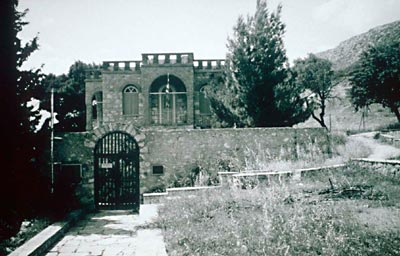
Sikelianos house at Delphi.
This is now the Sikelianos Museum, a house that Eva had built in 1925, and which served as the base for the Delphic Festivals. The loom that Eva used to weave the costumes for the plays,[3] built on Raymond Duncan’s design, is downstairs. There are letters in cases from the National Geographic Society, and from (or in reference to) some of the men and women whose lives touch Eva’s or Angelos’s lives at some point or another: Paul Valéry, Henry Miller, the Greek Prime Minister Emmanuel Benaki, Sarah Bernhardt, Eleanor Roosevelt, Paul Eluard, Rodin, Isadora Duncan. The house, each stone of which was chiseled by hand (Angelos complained of headaches from the years of tap-tap-tapping) lies at the final curve of Eva and Angelos Sikelianos Street, and is perched on the highest hill above the ancient site of Delphi, with views from the East onto the Phedriad crags of the Parnassus Mountains, not too far from Oedipus’s crossroads.
So Frances arrived, newly married, just in time for the second Delphic festival — Eva must have been mad with preparations, weaving costumes, making masks, ordering spears and bows and javelins to be fashioned. It seems that Frances quickly learned to weave, assisted in mask-making, and generally helped in the many tasks in preparation for the festival.
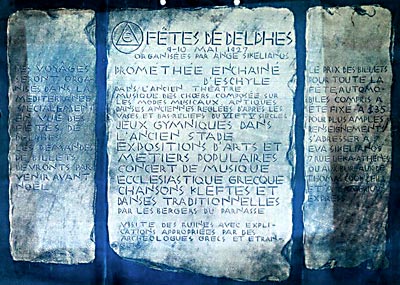
Poster from the 1927 festival.
The following three images are photocopied from a 1927 National Geographic article on the first Delphic Festival.
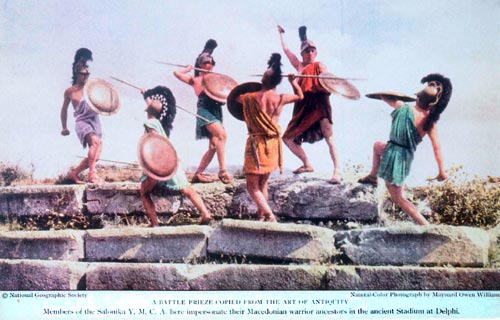
Javelin-throwing.
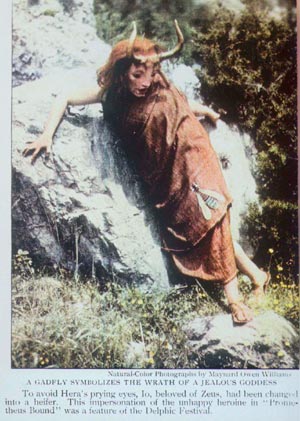
Io — someone who might show up in one of Anne’s poems.
A number of these costumes are in the Sikelianos museum — their colors still very bright, apparently because Eva used natural dyes.
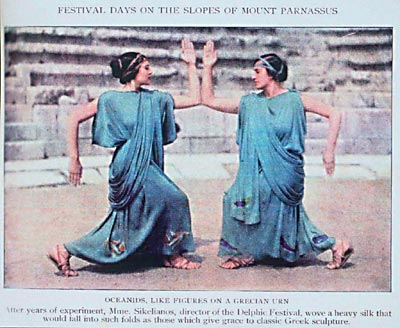
Oceanids (above and below)
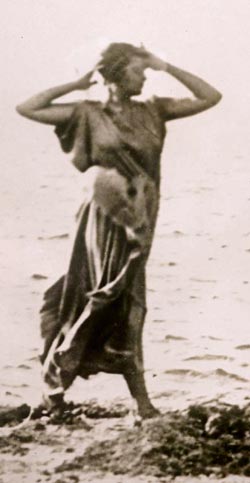
By the water
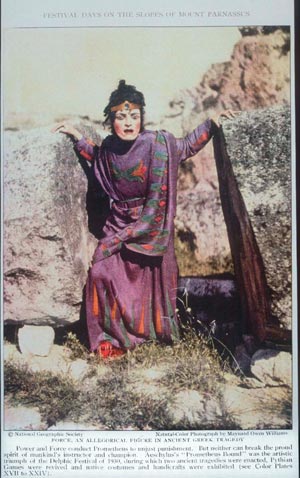
This is the embodiment of Force, a Greek allegorical figure — another embodiment of Anne, or of one of her poems?
Question: Have you always been a somnambulist, an insomniac?
Anne: Yes, little sleep. Too much to do, vast complicated projects envisioned all the time. I never feel I have enough aeons to do what I need to do before I die. I’ve always felt this, even as a young person. Isn’t sleep a kind of death? It’s always been hard to take a vacation, relax, lie in the dirt, idle.
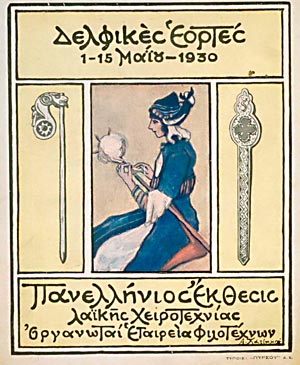
Cover of the arts & crafts pamphlet for the 1930 festival.
The following three photos from Frances’s collection of the 1930 festival productions.
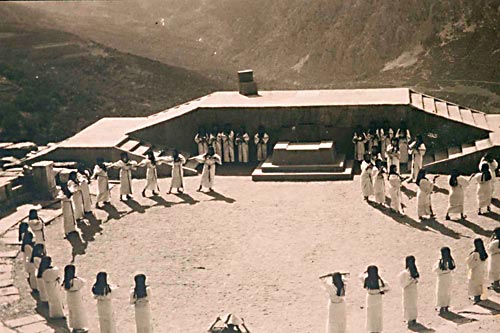
Above and below, The Suppliants, with which Frances must have helped.
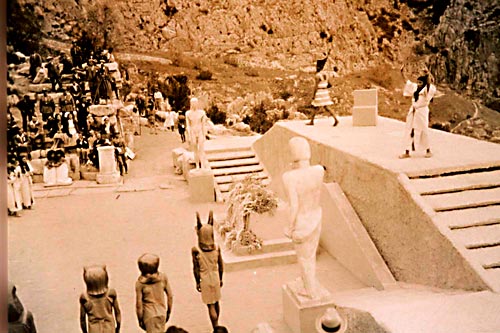

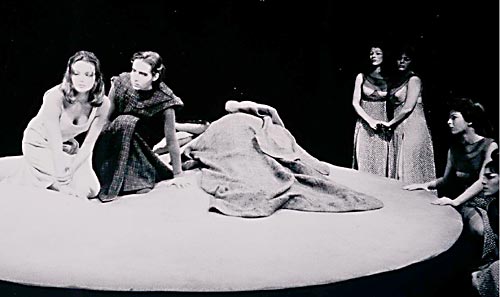
Anne playing Hippolyte.
Anne:
Frances spoke of her years in Greece all the time. This was the highpoint of her life. Her “roadtrip” as it were, her romantic and deep love affair with another culture to last her whole lifetime and also a primordial contact with the earthiness of existence, with the basics — pumping water, weaving clothes, making yogurt, living like a peasant to some extent. I think Eva was the most influential on Frances’ psyche and life, and made an early imprint as an individuated being. Frances’ own mother was somewhat of an invalid who was heartbroken because she couldn’t be a Christ Scientist missionary in Africa. Eva was strong-willed, an activist, bi-sexual, also spiritual, with a “vision” and means to accomplish it. I have several very strong memories of Eva as well — I’m age 5 in downtown New York — her extraordinary red hair greying now, her being definitively outside the norm. The “history” she shared with my mother and a very strong bond between them. Eva’s sorrow at the state of the world (she was a political being). Eva was not like other adults I witnessed. She was a trailblazer, unique in New York to me. Early on I identified Eva with the little I knew of H.D. Eva seemed the epitome of a free spirit. Her privilege gave her the power to be bohemian, radical, Luddite even. There are extant manuscripts and pamphlets of Frances’ translations of Angelos as well as the book The Border Guards I published under Rocky Ledge imprint before her death in 1982. The years in Greece — the Greek Festivals at Delphi and Frances’ role in the second one was part of our history as well — her loyal weaving, making masks, even her own homespun Kotex.
Angelos and Eva were co-conspirators in the great work: The Delphic Idea. By all accounts, the festival my mother worked on was Elysian, psychedelic, or something, imprinted on her genetic spine for all time. The sheer breadth and excitement and scope — community working toward some great “end” together was built into her aspirant mind.
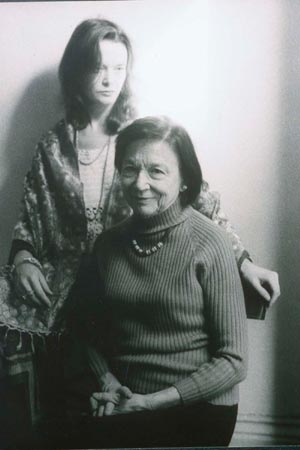
Anne and Frances, by Gerard Malanga.
The Sikelianos vision of a utopian festival (and eventually, they hoped, university) that would bring together poetry, music, theater and thought, and thereby end world conflict was an early “blueprint for community,” what Anne would call an “underground ‘autonomous zone.’” The formidable ideology and proto-feminist energy around these festivals in which Frances took part was passed on to Anne, who, in turn, became an incredible force in the creation of various sites of community — from her activities with Angel Hair magazine and books, the Poetry Project, Naropa University and The Jack Kerouac School of Disembodied Poetics, through later imprints Rocky Ledge and Erudite Fangs, and the current project to found a poetry residency on the Bowery. In anticipation of Anne, Frances’ parents-in-law were “making the world safe for poetry.”
Anne’s own work, conducted in an atmosphere of both rigor and permission, makes palpable a kind of restless energy, a searching engagement with the whole world and its “experiment.” A restive intelligence, drawing from every corner available — real-world speech, opulent realms of physical and psychic travel, visionary mutterings of the Pythian priestess — is manifested on the page in all the potential impulses and wild forms of Bohemia. As a body, it is a work that considers the whole field, takes in the whole utopian festival, as it were. As Anne writes in an early poem, “Giant Night”:
The hub of the universe is where I am in a night whose promise
grows with me.
Notes
[1] Variant transliteration into English. The Greek contains two “gammas’ (“gamos,” meaning “marriage” or “fucking”). The name, Αγγελοs, is pronounced with a hard “g.”
[2] Where Frances, also repatriated by then, continued to spend time with her.
[3] Aeschylus’s Prometheus was performed at the 1927 festival; both Prometheus and The Suppliants were performed in 1930. Eva studied the drape of ancient robes on vases and kylices in order to develop the proper weave of the costumes. Although silk was unknown in Aeschylus’s Greece, she decided on silk (if Aeschylus had known silk, he would have used it, she reasoned). She gathered the berries, twigs, and leaves to dye the wool herself. The preparation for the first festival took two years, in which Eva also studied Greek Byzantine modal structures to find the appropriate music, choreographed the play and trained a chorus of Athenian girls, had the hoplites’ bronze shields hand-hammered, and so on.
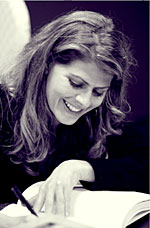
Eleni Sikelianos
by Rachel Zucker
Eleni Sikelianos is the author of, most recently, The California Poem (Coffee House Press) and The Book of Jon (Nonfiction / Memoir, City Lights). She currently lives in Colorado, and teaches at the University of Denver.
it is made available here without charge for personal use only, and it may not be
stored, displayed, published, reproduced, or used for any other purpose
This material is copyright © Eleni Sikelianos and Jacket magazine 2005
The Internet address of this page is
http://jacketmagazine.com/27/w-sike.html
